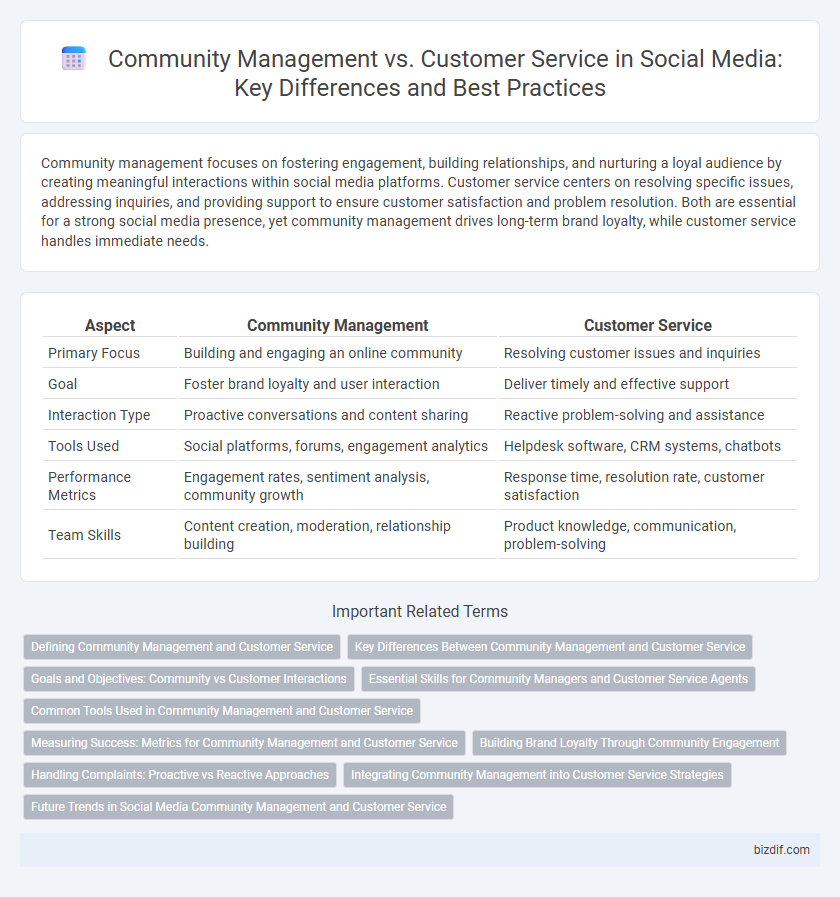Community management focuses on fostering engagement, building relationships, and nurturing a loyal audience by creating meaningful interactions within social media platforms. Customer service centers on resolving specific issues, addressing inquiries, and providing support to ensure customer satisfaction and problem resolution. Both are essential for a strong social media presence, yet community management drives long-term brand loyalty, while customer service handles immediate needs.
Table of Comparison
| Aspect | Community Management | Customer Service |
|---|---|---|
| Primary Focus | Building and engaging an online community | Resolving customer issues and inquiries |
| Goal | Foster brand loyalty and user interaction | Deliver timely and effective support |
| Interaction Type | Proactive conversations and content sharing | Reactive problem-solving and assistance |
| Tools Used | Social platforms, forums, engagement analytics | Helpdesk software, CRM systems, chatbots |
| Performance Metrics | Engagement rates, sentiment analysis, community growth | Response time, resolution rate, customer satisfaction |
| Team Skills | Content creation, moderation, relationship building | Product knowledge, communication, problem-solving |
Defining Community Management and Customer Service
Community management involves building and nurturing relationships with followers by fostering engagement, encouraging conversations, and creating a sense of belonging around a brand or organization. Customer service focuses on resolving individual inquiries, complaints, and support requests to ensure satisfaction and loyalty. Both functions are essential in social media management but serve distinct roles: community management drives ongoing interaction, while customer service addresses specific user needs.
Key Differences Between Community Management and Customer Service
Community management focuses on building and nurturing long-term relationships among social media followers to foster engagement and brand loyalty, while customer service addresses individual inquiries and resolves specific product or service issues. Community managers create content, moderate discussions, and encourage user interaction, whereas customer service representatives respond directly to complaints, troubleshoot problems, and provide timely solutions. The key difference lies in community management's proactive role in creating a vibrant online culture versus customer service's reactive role in solving immediate customer concerns.
Goals and Objectives: Community vs Customer Interactions
Community management focuses on fostering engagement, building relationships, and creating a loyal audience by encouraging conversations and nurturing brand advocates. Customer service aims to resolve individual issues, provide support, and enhance customer satisfaction through timely, personalized assistance. Both play crucial roles in social media strategy, with community management driving brand loyalty and customer service ensuring problem resolution and positive user experiences.
Essential Skills for Community Managers and Customer Service Agents
Community managers excel in content creation, audience engagement, and fostering brand loyalty through consistent interaction on social media platforms. Customer service agents specialize in conflict resolution, empathy, and timely response to queries or complaints to ensure customer satisfaction. Both roles require strong communication skills, problem-solving abilities, and a deep understanding of the brand's voice and customer needs for effective social media management.
Common Tools Used in Community Management and Customer Service
Community management relies on tools like Hootsuite, Sprout Social, and Discord for engaging audiences and fostering dialogue across multiple social platforms. Customer service employs Zendesk, Freshdesk, and Salesforce Service Cloud to efficiently track, manage, and resolve support tickets and inquiries. Both fields benefit from real-time monitoring, automation, and analytics features integrated into these platforms to enhance user experience and operational efficiency.
Measuring Success: Metrics for Community Management and Customer Service
Measuring success in community management involves tracking engagement metrics such as active participants, post frequency, sentiment analysis, and response time within social media groups. Customer service success is evaluated through resolution time, customer satisfaction scores (CSAT), net promoter score (NPS), and first contact resolution (FCR) rates across support channels. Integrating these metrics helps businesses optimize both community growth and customer experience for sustained social media ROI.
Building Brand Loyalty Through Community Engagement
Community management fosters brand loyalty by nurturing active engagement and meaningful interactions within social media audiences, creating a sense of belonging and trust. Customer service addresses individual issues and inquiries, ensuring satisfaction but often lacks the emotional connection that drives long-term loyalty. Effective social media strategies integrate community management to build authentic relationships that promote sustained brand advocacy.
Handling Complaints: Proactive vs Reactive Approaches
Community management involves a proactive approach to handling complaints by monitoring conversations, addressing concerns early, and fostering positive engagement to prevent escalation. Customer service typically takes a reactive role, responding directly to complaints after they arise through support channels. Effective social media strategies integrate both methods to enhance brand reputation and improve customer satisfaction.
Integrating Community Management into Customer Service Strategies
Integrating community management into customer service strategies enhances brand loyalty and drives proactive problem-solving by leveraging real-time consumer interactions on social media platforms. Community managers facilitate engagement, gather feedback, and address issues before they escalate, creating a seamless support experience that reduces response times and increases customer satisfaction. This approach uses social listening tools and engagement analytics to align social media activities with broader customer service goals, fostering a collaborative online environment where users feel heard and supported.
Future Trends in Social Media Community Management and Customer Service
Future trends in social media emphasize the integration of AI-driven chatbots and advanced analytics to enhance both community management and customer service. Predictive algorithms will enable proactive engagement, anticipating user needs and resolving issues before they escalate. Embracing omnichannel strategies ensures seamless interaction across platforms, fostering stronger community bonds while delivering personalized customer support.
Community management vs Customer service Infographic

 bizdif.com
bizdif.com